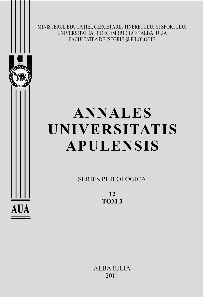Modele româneşti de traducere a poeziei. Ştefan Aug. Doinaş
Romanian Patterns of Translating Poetry. Ştefan Aug. Doinaş
Author(s): Mihaela DoboşSubject(s): Literary Texts
Published by: Universitatea »1 Decembrie 1918« Alba Iulia
Keywords: accurate translation; reading; interpretation; text; cultural space
Summary/Abstract: In the debates about the (in)translatable nature of poetry, supported by numerous theories - from the aesthetic to the exclusively linguistic ones -, Doinaş imposes himself with a clear conviction that provides practical proofs which state that poetry will not lose its genuine identity through translation. The writer elaborates a theory of the accurate translation of poetry, which is polarized by the theory of the masterpiece. According to that, a valuable poetical work cannot be transposed into a foreign language without being indefeasibly contaminated or even destroyed, having in mind Humboldt’s Romantic view about the monadic characteristic of the languages, real Weltanschauungs that depict the reality differently, as well as the principle of creation as a system of connotations, therefore impossible to be transferred beyond the boundary of two languages. Translating poetry, a fastidious and sublime operation of passe-muraille, represents a poetics, as well as a poietics, an authentic creation - up to a point - and an accurate reconstruction of the source-text, a lucid, competent, but also passionate insight in the poet’s laboratory, in order to re-establish the initial direction of the literary work. Aiming to convey the authentic, personal, and unique voice of a poet in the target-language, unbiasedly and without distortions, Doinaş-the translator creates an algorhythm for this complicated aesthetic and linguistic initiative. The first limit to be transcended, according to Ştefan Aug. Doinaş, is the aesthetic reading, the empirical one, reading for pleasure, initiated by the individual who has the undisguised awareness of him/her being a consumer of art. The translator imposes this passive and contemplative attitude the methodical reading of the experienced reader, whose attitude is active and operational, pragmatic and applied to the text. Resisting “the effect of reading” (Roman Ingarden), the mythology and psychology of the literary work, the translator should get over the transitional phase towards objectivity and analysis. The hermeneutical reading, according to Hans-Georg Gadamer’s theory, represents the next fundamental measure for the institution of the new work of art. Translating is neither more nor less than the textual fulfillment of the interpretation which the reader, in the persona of a translator, applies to the chosen text as a super- enlightenment (Überhellung) that makes it possible to read the text in a foreign language. Doinaş offers a nuance to the German thinker’s idea, asserting that the translator is not allowed to privilege an interpretation but to guarantee all the interpretations, as they are reflected in the text by the author. Doinaş considers that the opportunity of the translator to gain an insight into the “internal anatomy of the literary work” is ensured by the “genetic reading (practical or poietic reading)”. This form of reading absorbs the previous ones but it also exceeds them as a strategic initiati
Journal: Annales Universitatis Apulensis. Series Philologica
- Issue Year: 12/2011
- Issue No: 3
- Page Range: 43-54
- Page Count: 11
- Language: Romanian

